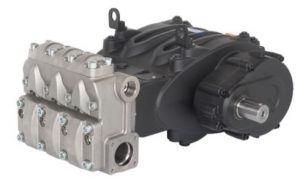
Operating Principle
A retracting plunger creates a suction effect in the liquid end and opens the suction valve. The medium flows into the liquid end. The plunger then moves forward. The plunger displaces the available volume through its own volume and increases the pressure of the fluid to be pumped. The suction valve closes and the pressure valve opens the way into the process area for the pressurized fluid. The forward and backward movement of the plunger repeats itself continuously and opens or closes the valves. Depending on the application, the cycles are repeated up to several hundred times per minute. Basically, the plunger pump consists of two main components: the power end and the liquid end.
Operating Range:
Flow Rate: up to 896 LPM
Pressure: up to 1500 Bar
Available with External Gear Box
General Applications for high-pressure plunger pumps
Plunger pumps can be used in a wide variety of applications. Wherever liquid media has to be pumped at high pressure, they provide suitable solutions. Applications range from pumps for cleaning processes of the lowest performance classes with a few kilograms to pumping systems for the process industry with performance requirements of several kilograms. Pressure stages of up to 1,500 bar can be achieved with our high-pressure pumps.
Typical applications for plunger pumps are:
Cleaning applications in Industries
Sewer Cleaning at municipalities
Pipe cleaning applications
Coal liquefaction
Process technology for the chemical and pharmaceutical industries
Pressure testing
Urea production
Surface preparation
Oil and gas production
.